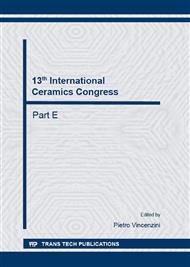p.19
p.24
p.32
p.39
p.48
p.54
p.64
p.70
p.79
Fabricating of Diatomite Based Ceramic Water Filter by a Novel Casting Method
Abstract:
In this study, a ceramic water filter with micron sized pores was developed based on diatomite raw material. The slip with diatomite earth which has tubular shaped particles was prepared by using agar. Agar is a gelatinous material derived from sea alges and used as a gelling agent in order to form ceramic filters by gel casting method. Rheology of the slip was investigated by rheometry. In the forming process, polymer and metal molds were used instead of plaster molds. After de-molding, ceramic filter samples were dried and fired at 1200 °C/ h for 2 hours. Density, phase analysis and microstructure properties of porous diatomite based filter material were measured and characterized by He picnometer, XRD and SEM, respectively. Water filtration performance and microbiological test results were also investigated.
Info:
Periodical:
Pages:
48-53
Citation:
Online since:
October 2014
Authors:
Keywords:
Price:
Сopyright:
© 2014 Trans Tech Publications Ltd. All Rights Reserved
Share:
Citation:


